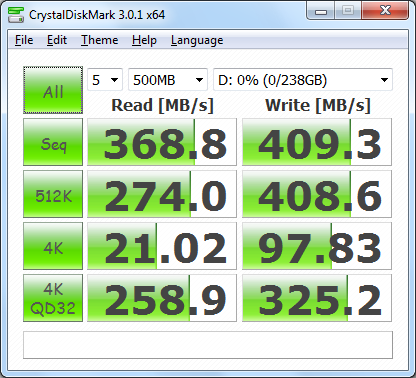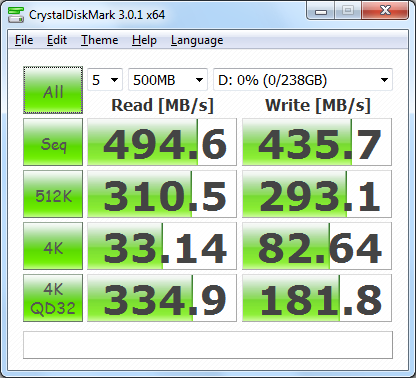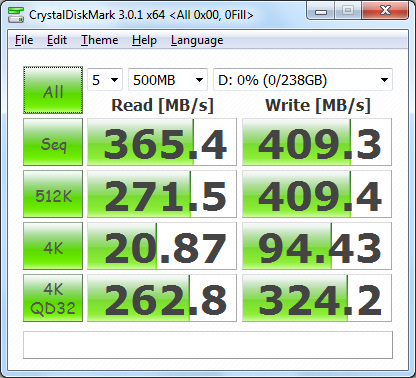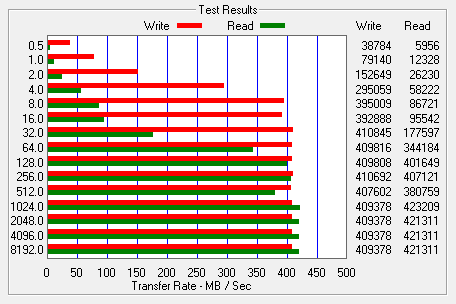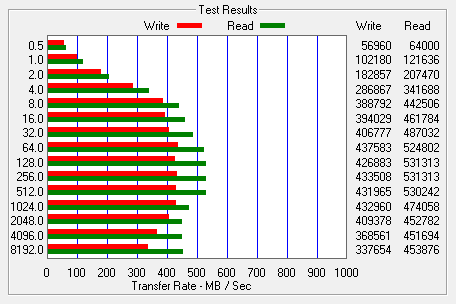The test system used in this review was an HP 8200 Elite. The computer came equipped with an Intel Core i5-2400 CPU, 4GB of DDR3 1333MHz memory, Seagate Barracuda 7200.12 ST3250312AS 250GB SATA 6 Gb/s hard drive, NVIDIA Quadro FX580 512MB PCIe graphics card and an Intel 82579-LM gigabit network card. For the operating system, I installed a fresh copy of Windows 7 Enterprise.
To test the performance of the OCZ Agility 4, I ran a series of benchmarks using CrystalDiskMark 3.0.1, HD Tach RW 3.0.4.0, ATTO Disk Benchmark 2.46, AS SSD, HD Tune Pro 4.61, Anvil's Storage Utilities and Iometer. For comparison, I've also included test results from the SanDisk Ultra Plus, Samsung SSD 840 Pro, Kingston SDNow V300, Silicon Power S70, Plextor PX-256M5P, OCZ Vertex 4, Kingston HyperX 3K, and SanDisk Extreme.
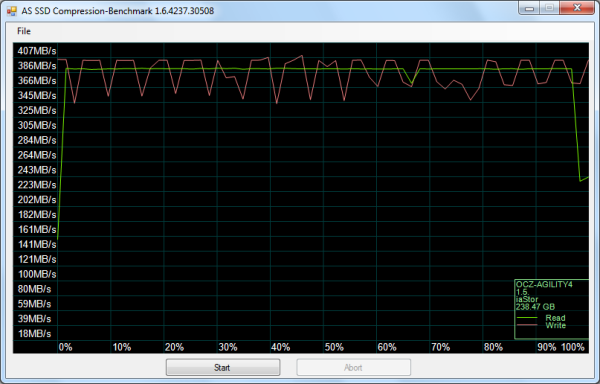
Like the Vertex 4, the Agility 4 is based on the Indilinx Everest 2 controller platform. Looking at the screenshot above, you can see that it performs equally well with both incompressible (0%) and compressible (100%) data.
CrystalDiskMark 3.0.1:
First, I ran a few quick tests using CrystalDiskMark. This benchmark tool measures the performance of a storage device by testing its sequential read and write speeds as well as its random read and write speeds using blocks 512K and 4K in size.
According to OCZ, the 256GB Agility 4 is capable of reading at 420 MB/s and writing at 410 MB/s when connected to a SATA 6 Gb/s port. While the drive performed relatively well, it came up a bit short of these numbers in CrystalDiskMark's sequential read and write speed tests.
The Agility 4 performed equally well when using highly compressible 0x00 (0 Fill) data. This time around, the drive was able to read at 365.4 MB/s and write at 409.3 MB/s.
HD Tach RW 3.0.4.0:
Next, I used HD Tach to test the Agility 4's read, write and burst speeds as well as its seek times and CPU usage.

Looking at the screenshot above, you can see that the Agility 4 had average read and write speeds of 163.5 MB/s and 229.1 MB/s respectively, as well as a burst speed of 151.6 MB/s.
These numbers aren't very impressive and this is primarily due to the Agility 4's performance and data storage modes. By default, the drive operates in performance mode and reads and writes at its maximum speed. The drive maintains this performance level until it's filled to about a quarter of its capacity. At this point, the Agility 4 switches to data storage mode and the read and write speeds drop by half so that it can reorganize the pages on the drive. If you continue to fill the drive without waiting for this task to finish, the writing speed will drop again at the three-quarter mark. Thankfully, these drops in performance are not permanent. Once the Agility 4 is done reorganizing the pages, its performance returns to normal.
ATTO Disk Benchmark 2.46:
I also used ATTO Disk Benchmark to test the Agility 4's sequential read and write speeds. The tests are run using blocks ranging in size from 0.5KB to 8192KB and the total length set to 256MB.
When tested with ATTO, the Agility 4's read speeds topped out at about 421 MB/s and its write speeds at 410 MB/s.


